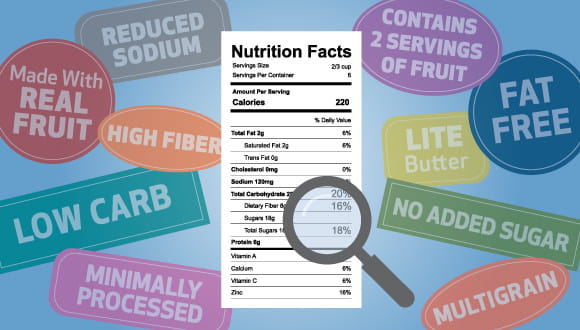5 Tips for Avoiding Misleading Food Label Claims
March 30, 2023 - Katie McCallumNo matter which aisle of the grocery store you're wandering, there's no shortage of label claims to sift through on the packaged foods we see on the shelves.
- Fat Free
- Reduced Sodium
- Low Carb
- High Fiber
- Minimally Processed
The list could go on, of course, but what does any of it really mean? Can you count on these labels to help you choose healthier packaged products?
5 tips for dodging misleading food label claims
Now that you know what to watch out for, Monica Bearden, a registered dietitian at Houston Methodist, has tips for making healthier choices:
1. Choose whole foods, over packaged ones, as often as possible
This one may seem like a no-brainer, but the reality is that almost 60% of the average American's calories come from processed foods, according to the NIH.
"The best way to avoid eating unhealthy additives, including added sugars, trans fats and excess salt, is to limit processed foods, fried foods and sugary beverages — primarily eating fresh, whole foods instead," says Bearden.
It's also the most nutritious way to eat. Fruits, vegetables, whole grains, lean cuts of meat and foods containing healthy fats provide the nutrients, vitamins and minerals your body needs to function optimally — things processed foods are often lacking.
2. When choosing packaged foods, watch out for these label claims
You don't have to cut processed foods out completely, but you should try to choose the healthiest options whenever possible. If you didn't do so hot on the quiz above, we've got you covered.
Here are a few food label claims that are particularly misleading and what Bearden says to focus on instead:
- Fat Free – Check the serving size. "Free" actually means the product must contain 0.5 grams or less. But how many servings do you plan to eat? Those grams can add up quicker than you realize. Saturated fats should be limited and trans fats should be avoided altogether. Apply a similar strategy for "Sugar Free" and "Zero Trans Fats" claims.
- Reduced Sodium – Check the sodium content daily value (DV) percent. If it's 20% or higher, the item is considered high in salt and choosing a low-salt alternative is the healthier option. Apply a similar strategy for "Reduced Sugar" and "Reduced Fat" claims.
- Low Carb – This doesn't mean anything right now. A healthier way to approach carbohydrates in packaged goods is to look at the nutrition label and choose an item that contains dietary fiber and has no more than 5% DV of added sugars.
- X Servings of Fruit – Check the ingredients list. If you don't see real fruit, then the product doesn't contain the nutrition of real fruit and will typically instead have a lot of calories and sugar.
3. Avoid trans fats
Regardless of what the label says — and even if it says "Zero Trans Fats" — flip the package over and check the nutrition facts label for the presence of trans fats.
"Trace amounts of trans fats occur naturally in foods, but processed foods provide the greatest amounts of trans fats in our diets," says Bearden. "This type of fat, in particular, should be limited, as studies suggest trans fats increase the risk of heart disease by contributing to high cholesterol."
Bearden adds that you can find trans fats in surprising places, like microwave popcorn. (She recommends air popping your own popcorn for a healthy snack.)
4. Get plenty of fiber, but spread it out between meals
"Fiber in foods is good for you, whether it's naturally found in the food or added," says Bearden. "However, it can cause gas and bloating. This is not necessarily a bad thing, as the gas is a by-product of the beneficial bacteria in the gut metabolizing the fiber."
It does mean, though, that you'll want to eat high fiber products in moderation and try to incorporate them at each meal instead of consuming a large amount all at once.
5. When searching for a healthy bread product, skip to the ingredient list
Not all types of bread are created equal. It's best to choose whole grain options, but — from "multigrain" to "whole wheat" and beyond — the labels aren't always as helpful as you might think. Instead, turn the package over and look at the ingredient list.
"To determine if a bread product is healthy, look for an actual whole grain to be listed either first or second in the ingredient list," recommends Bearden. "Examples of whole grains include whole wheat, oats and corn."








